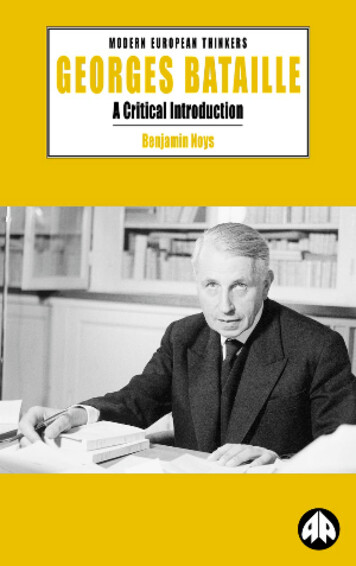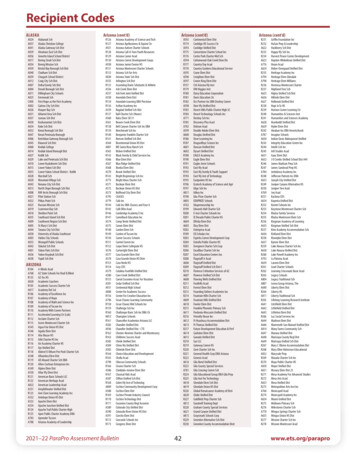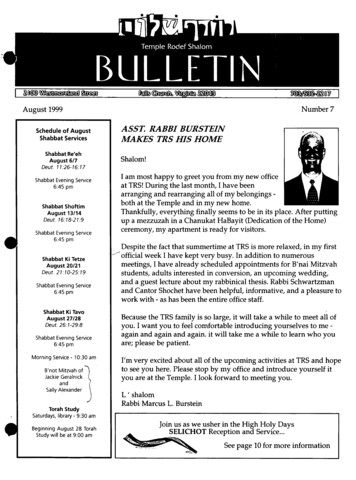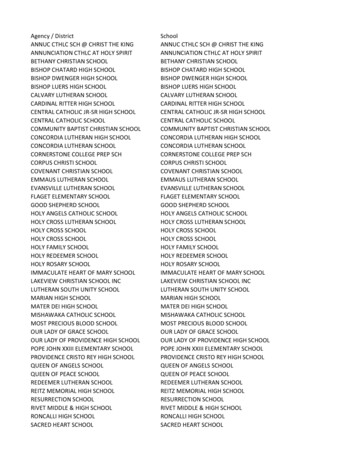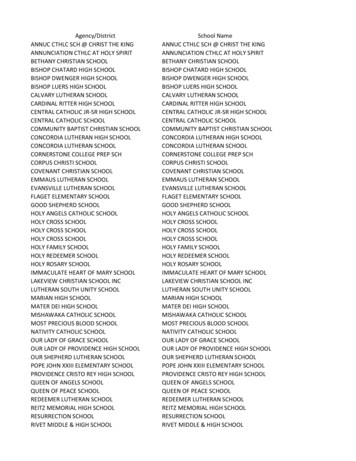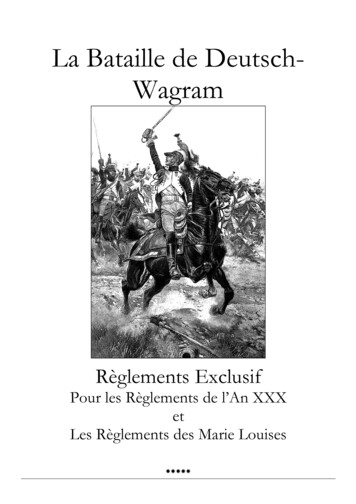
Transcription
La Bataille de DeutschDeutWagramRèglements ExclusifPour les Règlements de l’An XXXetLes Règlements des Marie Louises
La Bataille de Deutsch-WagramCopyright 2010 Clash of Arms.2September 6, 2010Rules marked with an eagle or are shaded with a greybackground apply only to players using the Règlements del’An XXX.All rules herein take precedence over any rules in the series ruleswhich they may contradict.Modified: September 26, 2010Printed: September 26, 20101.0 INTRODUCTIONLa Bataille de Deutsch-Wagram is a tactical Napoleonic game ofNapoleon’s battle of the 5th & 6th of July with the Archduke Karlwhich decided the 1809 Danube campaign.2.0 RULES QUESTIONSClash of Arms Games1804 Hoffmansville RoadPO Box 212Sassamansville, PA. 19472-0212Or email us at: sales@clashofarms.com“Attention: Rules Questions Wagram”forumat4.2.1 Austrian Landwehr Corrections: Modify the counter valuesfor the following units as noted below or download replacementcounters from the aforementioned website.NOTE: In the original game only the 4 worst errors wereincluded as stick-on labels. 1/2 1H 3/5/43 3/2 2Be 3/4/42 1/2 4K 3/14/43 4/2 1I 3/8/43 2/1 2Z 3/7/41 4/2 1Z 3/7/42 2/1 3H 3/7/42 4/3 2O 3/6/44 2/1 1B 3/8/44 6/1 3M 3/7/36 2/1 3B 3/9/44 6/1 OA 3/5/52 2/2 2K 3/13/45 6/2 1W 3/6/46 3/2 Pr 3/4/51 6/2 2W 3/6/46 3/2 1Be 3/6/41 6/3 3A 3/9/43 6/1 3K 3/4/424.2.2 Austrian Infantry Corrections: Modify the counter values forthe following units as noted below or download replacement countersfrom the aforementioned website.Send questions or comments to the following address:Or check the La Bataillehttp://www.consimworld.com. Consimworld: 3.0 GAME COMPONENTSA complete game of La Bataille de Deutsch-Wagram includes thefollowing components:1. Four 34” x 22” maps and one 17” x 22” (or 34” x 44” DTP)map2. A lot of counters3. One Series Rules book4. One Exclusive Rules Book5. Charts and tables6. Six organizational displays7. Game Turn Record Track8. Terrain Effects Chart4.0 COUNTER AMENDMENTSThese amendments are the additional leaders required for commandpurposes and for various OOB changes. In general, the OOBchanges increase the strength of the Austrians while decreasing thestrength of the French.NOTE: The following additional leader counters are required toplay the game. Download the leader and AAW counters from thewebsite http://LaBataille.us. The replacement and optional counterslist below are also available in the same file as the leaders on thewebsite.4.1 French Add Infantry Brigade Leader, Carcomelego (PT/II) 0-10 -/-/-/1Add Cavalry Brigade Leader, Colbert (LC/II) 0-15 -/2/-/2Add Cavalry Brigade Leader, Preysing (LC/VII) 0-15 -/2/-/24.2 Austrian o 1st Brigade, Riese, 0-6,-/-/-/1o 2nd Brigade, Mayer, 0-6, -/-/-/1Add ADC to Rosenberg 0/6 -/-/-/1Add the Advanced Guard Korps Brigade commanderso Light Brigade, Frelich, 0-12,-/2/-/23/23/23/23/23/23/23/23/278/78/25 4/2 88/36/217/1 4/26/26 4/2 8/1 4/13/227/2 4/26/26 4/2 8/2 4/12/227/3 4/26/26 4/2 8/3 4/11/2256 8/47/26 4/2 22 8/39/2156/1 4/17/31 4/2 22/1 4/14/2256/2 4/16/31 4/2 22/2 4/13/2256/3 4/14/31 4/2 22/3 4/12/224.2.3 Artillery Ammunition Wagons: AAW counters canbe found on the website.NOTE: Ammunition rules only apply to players usingthe Règlements de l’An XXX.4.3 Optional ForcesThe optional forces and OOB changes listed here can be used ifplayers agree. Where additional counters are required the optionalforces are marked as VARIANT and have a grey background.4.3.1 Austrian V Korps (FZM Prince Reuss): The Austrian VKorps was detached to watch for a crossing of the Danube upstream(E13.9).4.3.2 Army of Inner Austria (Archduke Johann): Johann’s Armyfailed to make the battlefield leaving the Austrian left (east) flankexposed (E13.8).4.3.3 French Lobau Garrison (Général de division Reynier): Thegarrison is abstracted in the original Race for the Bridges scenario.The garrison is required for the Drive for the Bridges scenario inthese rules.4.3.4 Austrian Landwehr: Archduke Karl had reorganized theAustrian Landwehr just before the 1809 campaign started. The besttroops were merged into 16 Battalions intended to provide skirmishersupport to the line regiments. These included the 6 battalions of theArchduke Karl Legion, 4 battalions of Inner Austria Volunteers, 2battalions of Moravian-Silesian Volunteers, a battalion of MoravianVolunteers, and 3 battalions of Galician Volunteers. The Legion andthe Freicorps should be skirmish capable and at least as good as thestandard Landwehr. The following units should be consideredskirmish capable: I Korps/2nd Division, 4th Btn, Archduke Karl’s LegionII Korps/2nd Division, 2nd Btn, Archduke Karl’s LegionIV Korps/3rd Division, Carneville Freicorps BattalionNOTE: Carneville was last seen in the Advanced Guard at LaBataille d’Austerlitz
La Bataille de Deutsch-Wagram 3V Korps, 5th Wien Freicorps BattalionVI Korps/1st Division, 3rd Btn, Archduke Karl’s LegionVI Korps/ 2nd Division, 1st Wien Freicorps BattalionVI Korps/ 2nd Division, 2nd Wien Freicorps BattalionVI Korps/ 3rd Division, 3rd Wien Freicorps BattalionVI Korps/ 3rd Division, 4th Wien Freicorps Battalion4.3.5 Austrian 64th Chasseur Tyrol Regiment (Advanced GuardKorps): This regiment had been broken up to provide the cadre forthe Jäger Battalions. Remove them from play.4.3.6 Austrian 3rd Division of the VI Korps: This division is(mostly) missing from the original counter mix. Add the followingunits: FML Friedrich Freiherr von Kottulinsky2 Brigade Batteries51st Infantry Regiment, Splenyi (1st, 2nd, 3rd Btns)31st Infantry Regiment, Benjovszky (1st, 2nd Btns)3rd Wien Freicorps Battalion4th Wien FreicorpsBattalion4th Mahr Landwehr Battalion4.3.7 Hesse-Darmstadt Infantry: The organization of the HesseDarmstadt Infantry was somewhat unique among Napoleon’s allies.They functioned by brigades. Each brigade consisted of one fusilier(light) battalion and a musketeer regiment of two battalions. HesseDarmstadt fielded three such brigades. The 2nd Brigade (Gross undErbprinz Brigade ) was deployed in Spain. This brigade consisted ofthe 2nd Leib Fusilier battalion and the Gross und Erbprinz regiment(2nd Musketeers). Later the 2nd Leib Fusiliers were merged into theline battalions (see La Bataille de Talavera). The original Wagramgame incorrectly includes the units which were in Spain, instead ofthe units of the 1st Brigade (Leib Brgiade). Remove the HesseDarmstadt infantry include in the original game and use the providedreplacement counters for the Hesse-Darmstadt contingent.4.3.84.3.9 Baden Contingent: The Baden contingent was part of theFrench IV Corps in Legrand’s division. Part of the Baden contingentwas stationed on Lobau Island. The Baden contingent is missing fromthe original counter mix. Add the following units: 1st Baden Grossherzog Regiment (x2)2nd Baden Erbgrosherzog Regiment (x2)3rd Baden Graf Hochberg (x2)Jäger Btn Lingg (Rifles)Baden Reitendebatterie (1/2 Battery)Baden Batterie zu Fuß4.3.10 Additional Austrian Artillery: Add the following batteries tothe Austrian Order of Battle: A/2 Cavalry Battery, Advanced Guard2/3 Position Battery, II Korps4/3 Brigade Battery, III Korps4/3 Position Battery, IV Korps6/3 Position Battery, VI Korps6/1 Cavalry Battery, VI Korps5.0 TERRAIN5.1 EarthworksDesigner’s NOTE: Wagram is one of the few major Napoleonicbattles where field works were extensively employed (Moscowa andDresde were others). Before the battle of Aspern-Essling Napoleonused a considerable number of field works to form a Bridgehead atthe north end of the bridge constructuted from Lobau Island, and onislands in the Stadtler Arm of the Danube (a Guard 12lb battery herebroke up one attack on Essling). These were further reinforced afterthe battle, using guns from the Vienna Arsenal. Archduke Karl hadbuilt a line of redoubts between Aspern and Essling to prevent arenewed crossing from the bridgehead, but Napoleon’s crossing eastto the Marchfield from Lobau made these redundant and they wererolled up by the leading cavalry elements. Archduke Karl then builtfurther redoubts overlooking the Russbach Stream during the night ofthe 5/6th July.French Bridgehead: A line of Earthworks was built about 500mnorth of the original site of the crossing to Aspern-Essling. These arerepresented by 5 Lunettes.Lobau Island: All unlimbered artillery on Lobau Island or onStadtler Arm islands are in Lunettes.Austrian Redoubts: During the night of 5/6th July redoubts werebuilt along the Russbach Heights, these are represented by 5Lunettes. For certain scenarios the Austrian player may place themeast of the Russbach prior to starting play.5.1.1 Facing: A unit in an Earthwork hex can be considered to beinside or outside of the Earthwork. All units in a stack must be insideor outside of the Earthwork. Only units which are inside receive thedefensive benefits of the Earthwork. The determination of inside oroutside is made by the facing of the units in the Earthwork hex, evenwhen the units are in Disorder or PGD. Units inside the Earthworkface a hex vertex. The units are considered inside the Earthwork ifthe vertex they are facing is at the junction of two Earthwork fronthexsides, otherwise they are considered to be outside of theEarthwork. Regardless of which qualifying vertex units inside theEarthwork face they are considered to have the same facing as theEarthwork. Infantry units in Good Order outside of the Earthworkare assumed to be in Column, unless in Disorder and may not formSquare even in reaction to an enemy Charge. Infantry units inside anEarthwork are deployed with their front side up. They may not bedeployed in Skirmish Order while inside the Earthwork, though theymay move through it while in Skirmish Order.5.1.2 Lunettes: The front hexsides of a lunette are indicated by theyheavy brown lines. All other hexsides of the lunette are rear hexsides.5.1.3 Stacking: For unit inside of an Earthwork, a maximum of onebattalion, or 6 increments of infantry, and one battery, of any size,may stack in an Earthwork hex. For units outside of an earthwork, amaximum of one battalion or 6 Increments of infantry or oneIncrement of artillery may stack in the hex.NOTE: For the Règlements de l’An XXX, a leader isnot required for units to stack in an Earthwork hex.5.1.4 Cavalry may not voluntarily enter Earthwork hexes, eitherduring movement, Advance after Charge or Pursuit. They may,however, still Charge and Mêlee units in Earthworks. And eventhough cavalry units may not enter an Earthwork they still Disorderin the “Advance after Charge” step following a Mêlée against unitsinside the Earthworks.5.1.5 Zones of Influence: Zones of Influence extend into and out ofEarthwork hexes.5.1.6 Line of Sight: Earthworks do not block Line of Sight.5.1.7 Formation: Units inside Earthworks, are in a kind of GeneralOrder, except that their facing and front, flank and rear hexsidesconform to the type of Earthwork in which they are deployed. Unitsinside Earthworks may not form Line, Column or Square.5.1.8 Fire Combat: Units inside an Earthwork fired on through thefront hexsides of an Earthwork receive the defensive fire benefit of
La Bataille de Deutsch-Wagram4the Earthwork. Units inside an Earthwork fired on through flank orrear hexsides have the Fire Defense of units in Column in clearterrain. Units outside of an Earthwork use the column on the FireDefense Chart for Clear terrain.5.1.9 Firing from Inside an Earthwork: One infantry and oneartillery unit may fire from an Earthwork. Infantry units use theirprinted Fire Value.5.1.10 Assaulting Earthworks: Units assaulting an Earthworkthrough the Earthwork’s front hexsides modify their Roll to Closedice roll by -3.5.1.11 Charging Earthworks: Cavalry which charges an Earthworkthrough its front hexsides have their Mêlée Value multiplied by 1/3.Cavalry which successfully charges units in an Earthwork do notadvance into the Earthwork in the Advance after Charge step andsince there is no advance there are no Opportunity Reactions.However, the units which Charged still become Disordered, if notalready Disordered. There is no Pursuit of units in Earthworks. Skipthe Pursuit step of the Mêlée procedure. After the Mêlée results areexecuted, if any, the cavalry may conduct Cavalry Regroupmovement if allowed and the Charge ends.NOTE: This modifier supersedes all other Mêlée Valuemodifiers applicable to cavalry.Designer’s NOTE: For the most part the earthworks wererelatively small and do not occupy the entire hex. Indeed in manycases not all the troops and guns positioned at the earthworks couldfit inside and were deployed beside or behind. In addition theearthworks were relatively short in height and numerous shot andshell passed over. Also, keep in mind the earthworks are notunassailable bastions of defense. Without an active defendermounting counterattacks and sending in reinforcements they aremerely piles of dirt.5.1.12 Austrian Artillery in the Russbach Earthworks doesnot consume ammunition.5.1.13 French Artillery in the Bridgehead Earthworks orLobau/Stadtler Arm Islands does not consumeammunitionNOTE: Ammunition rules only apply to players using theRèglements de l’An XXX.5.2 Streams and Bridges5.2.1 Streams:5.2.1.1 Only infantry and light cavalry units may cross an unbridgedstream hexside. All artillery and heavy cavalry units may only crossa stream at a bridged hexside. Personalities may always move freelyacross streams.5.2.1.2 Cavalry may not Mêlée, Charge or Pursue across unbridgedstream hexsides.5.2.1.3 Infantry assaulting across unbridged stream hexsides mustapply a -12 Roll to Close modifier.5.2.1.4 Units that are forced to retreat across the Russbach Stream,that are not normally allowed to cross it, become PGD and lose oneincrement.5.2.2 Bridges: Combat units may Assault or Charge across a bridge,but the following conditions apply.5.2.2.1 The assaulting unit may not make an Offensive Fire Attackduring the Assault Procedure.5.2.2.2 Only one infantry battalion or cavalry regiment may Assaultor Charge across a single bridge hexside.5.2.2.3 Infantry must be in Column (Battalion Masse) or SkirmishOrder when assaulting across a bridge. Cavalry units must be inColumn in order to Charge across a bridge.5.2.2.4 Infantry subtracts 6 from its Roll to Close dice roll, whenassaulting across a bridge.5.2.2.5 Cavalry units multiply their Mêlée Value by 1/3 as if thecavalry was attacking into General Order.5.3 Flood DykesDesigner’s NOTE: There are flood dykes surrounding Aspern &Essling as well as a dyke connecting the two villages. Aspern Churchand The Master’s Garden are outside the flood dykes.5.3.1 When fired on exclusively through Flood Dyke hexsides add 6to the Fire Defense of the units in the hex.5.3.2 Units assaulting across a Flood Dyke hexside modify their Rollto Close dice roll by -6.5.3.3 Units which are assaulted or charged exclusively across FloodDyke hexsides have their Roll to Stand dice roll modified by 6.5.3.4 Cavalry which charges across a Flood Dyke have their MêléeValue multiplied by 1/3. Cavalry which successfully charges unitsbehind a Flood Dyke do not Advance after Charge, but if a Mêléewas conducted it still becomes Disordered, if not already Disordered.There is no Pursuit of units behind Flood Dykes. Skip the Pursuit stepof the Mêlée procedure. After the Mêlée results are executed, if any,the cavalry may conduct Cavalry Regroup movement if allowed andthe Charge ends.5.3.5 Stacking: Units behind a Flood Dyke use the other terrain inthe hex to determine stacking limitations.5.3.6 Zones of Influence: Zones of Influence extend across FloodDyke hexsides.5.3.7 Line of Sight: Flood Dykes do not block Line of Sight.5.3.8 Formation: Units behind a Flood Dyke use the other terrain inthe hex to determine the permitted formations.5.4 Special StructuresDesigner’s NOTE: The special structures are all on the Drivefor the Bridges map, Aspern Church & Graveyard were on a moundjust west of Aspern Village and surrounded by a chest high stonewall, the Granary, stone built with iron doors and barred windowswas on the north side of Essling Village. The Master’s Garden was astone walled garden just north of Essling, adjacent to a stone Dairy.The Master’s Garden represents both these structures.5.4.1 Line of Sight: Special Structures block Line of Sight.5.4.2 Zones of Influence: Zones of Influence do not extend intoSpecial Structure hexes.5.4.3 Stacking: Up to 6 increments or 1 battalion of infantry maystack in a Special Structure hex. Units may voluntarily stack in aSpecial Structure without the presence of a friendly leader.5.4.3.1 Regimental Presentation: Infantry units in RegimentalPresentation with more than 6 increments, and which have battalioncounters, must break down into battalions before entering a SpecialStructure hex. The battalions entering may total no more than 6increments. These rules apply for all forms of movement voluntary orinvoluntary.5.4.4 Movement: Only infantry may deploy in a Special Structurehex. Cavalry and artillery may not enter a Special Structure hex,except to pass through it and only if they enter and exit via aroad/highway or trail while in Road Column. A cavalry or artilleryunit that passes through the hex may not stop in the hex, and may notenter the hex unless its current movement potential is sufficient toallow it to continue into the adjoining hex.5.4.5 Formation: A unit deployed in a Special Structure is alwaysconsidered as if in Square as long as it is in good order (notDisordered or PGD). It thus has the facing and Zone of Influence of aSquare, the firing pattern and fire effects of a Square, and the moralemodifier of a Square. Unlike a Square a unit in a Special Structuredoes not have to subscribe to the 3 increments minimum to receivethese benefits. Units may not employ Skirmish Order while in aSpecial Structure. No unit may be deployed in a Special Structure andin some other hex at the same time.5.4.6 Fire Combat: Infantry units firing on a Special Structure halvetheir Fire Values. Artillery firing on a Special Structure does notreceive the Point Blank Range benefit and uses its Long Range FireValue regardless of the actual distance. Regardless of the size ofdefending forces, a maximum of 6 increments may be used to firefrom a Special Structure.
La Bataille de Deutsch-Wagram55.4.7 Assault: Only infantry may Assault a Special Structure hex(that is Cavalry may neither Charge nor Mêlée units in SpecialStructures). Only 6 increments may Assault or defend a SpecialStructure hex. Regardless of the size of the forces, only six parts ofthe attacking or defending forces may be used for attack or defense.Infantry assaulting one of these hex does not have its Mêlée Valuemodified as if attacking a Square.5.4.7.1 Roll to Stand: Units in Special Structures automaticallyStand when assaulted. They must still roll the dice, however, todetermine if they deliver effective Defensive Fire and receive anyDefensive Shifts, but do not Disorder for Roll to Stand failure.5.4.7.2 Sapeurs: Sapeurs stacked with infantry in an Assault on aSpecial Structure hex will cause a one column shift in their favor onthe Assaut et Mêlée Chart. They must be part of the assault to causethis column shift.5.4.7.3 Assault and Mêlée Results: Defending units ignore all DRand DD# combat results on the Assaut et Mêlée Chart, instead theylose one increment from their strength.5.4.7.4 Roll to Close: Remember to apply the slope modifier for allassaults on the Aspern Church.5.5 Russbach Marsh / SwampMAP ERROR: On the map that contains Scenario 2 there is acluster of 3 wooded hexes near the Russbach Stream. The Swamphexes immediately adjacent to these woods hexes should beconsidered clear terrain.5.5.1 Only infantry may enter Swamp hexes. In order to enter (orAssault into) a Swamp hex the infantry must pass a Morale Check. Ifsuccessful enter the Swamp hex, paying the movement cost to enterthe hex(es). If unsuccessful stand in place and move no further andmake no formation or facing change.5.5.2 Infantry, which are not in Skirmish Order, that are forced toretreat into a Swamp become PGD and lose 1increment per Swamphex exited during their retreat.5.5.3 Artillery may only enter Swamp hexes through connecting trailor road hexes. They may not unlimber in a Swamp hex.5.5.4 Cavalry may not Charge into Swamp hexes. Nor may theconduct Pursuit into such hexes.5.6 Aspern-Essling SwampsThe swamps around Aspern-Essling contained many tracks, whichare not marked on the maps, so are more accessible to infantry andcavalry units.5.6.1 Infantry and cavalry units that are not in Skirmish Order enterGeneral Order upon entering a Swamp hex.5.6.2 Artillery may only enter Swamp hexes through connecting trailor road hexes. They may not unlimber in a Swamp hex.5.7 Villages5.7.1 Line of Sight: Village hexes block Line of Sight.5.7.2 Stacking: Village hexes require formed units, (i.e. those not inSkirmish Order, Disorder or PGD), to enter General Order uponentering.5.7.3 Cavalry Charge: Cavalry may not Pursue retreating units intoVillage hexes. The Pursuit stops at the Village’s edge.5.8 Woods5.8.1 Line of Sight: Woods hexes block Line of Sight.5.8.2 Stacking: Woods hexes require formed units, (i.e. those not inSkirmish Order, Disorder or PGD), to enter General Order uponentering.5.8.3 Cavalry Charge: Cavalry may not Pursue retreating units intoWoods hexes. The Pursuit stops at the Wood’s edge.5.8.4 Artillery may only enter Woods hexes through connecting trailor road hexes. They may not unlimber in a Woods hex.5.9 General OrderThe following terrain requires formed units to enter General Orderwhen entering: Special StructuresWoodsVillagesAspern-Essling Swamps5.10 Depots5.10.1 French: The South map edge east of Raasdorf, and / or thebridges over the Stadtler Arm onto Lobau Island.5.10.2 Allies: Any road leading off the North or West map edge, ifArchduke Johann enters then his Korps may use the east edge northof the Russbach.5.11 Terrain and Artillery RicochetArtillery fire which targets the following hexes terminatesin them. Ricochet fire may bounce into, but not through thefollowing hexes. Earthworks Villages Wood hexes Swamp hexes Special StructuresNOTE: Artillery Ricochet only applies to the Règlements de l’AnXXX.5.11.1 Slopes and Artillery Ricochet: Artillery Ricochet terminateswhere it meets an upslope or Flood Dyke hexside. Where ArtilleryRicochet meets a down slope hexside, the slopes creates a one hexshadow over which the shot will pass with no effect beforecontinuing along the shot path.6.0 COMMANDThe Organization and Display Charts reveal the command structureof the armies. Refer to them as necessary.6.1 Cavalry Brigade LeadersSome French infantry corps also have cavalry attached. In mostcases the cavalry is attached to the Corps in brigades. In the case ofbrigades, the cavalry brigade leaders are In Command if they arewithin 6 hexes of their Corps leader and may be part of a Corps sizedMU provided the corps leader is Activated. Light cavalry leaders mayroll for initiative to form their own MU.6.2 French6.2.1 Command Points: The French receive one Command Point forNapoléon, Oudinot, Davout, Massena, Bernadotte, Marmont, Eugène,Macdonald, Grenier, (Reynier) when they are on the map for a totalof 10 Command Points.6.2.2 Reynier: Reynier’s CP may only be used on Lobau Island orinside the bridgehead. He may form an MU with any units,regardless of their higher unit affiliation, within his Command Spanwhich are also on Lobau Island or inside the bridgehead.6.2.3 MU Size: The largest MU which the French may create is aCorps d’armée.6.2.4 Headquarters Escorts: Napoléon’s Headquarters Escorts mayonly move during the Leader Chit when he is allowed to move. If theowning player chooses, his Escorts may instead be treated as ArmyAssets.6.2.4.1 Napoléon is not allowed to assume the Movement Potential ofunits with which he is stacked as in the series rules under section 8.6.2.5 Leader Casualties: The following leaders may not be replaced:Napoléon, Oudinot, Davout, Massena, Bernadotte, Marmont, Eugène,Macdonald, Grenier, Bessières, Reynier.6.2.6 III Corps: Montbrun from the Reserve Cavalry commands aLight Cavalry Division attached to the III Corps consisting of boththe III Corps cavalry and his own cavalry brigades. His division isconsidered to be part of the III Corps.
La Bataille de Deutsch-Wagram66.2.7 Saxons: The Saxon cavalry of the IX Corps d’armée areconsidered Corps Assets and may be assigned to the Saxon InfantryDivisions of the same Corps.6.2.8 Bavarians: Only Wrede’s 2nd Division and a Light CavalryBrigade took part at Wagram, the remainder of the Corps waselsewhere.6.2.9 Organization: Napoléon reserved the command of his Guardfor himself. The Old and Yound Guard may not be committed until atleast one French and one Austrian formation are on Level 1. As suchla Garde is made up of four separate elements: Vielle Garde Jeune Garde Cavalerie de la Garde Artillerie de la Garde6.2.10 The Artillerie de la Garde may be attached to other MUs asArmy Assets or may form part of a Grand Battery MU as outlinedbelow. The Vielle Garde, Jeune Garde, and Cavalerie de la Garde, aretreated as separate command formations. They cannot form as asingle MU, but instead must form separate MUs.they may move, limber and unlimber when their chit is pulled. TheGrand Battery need not retain its organization from turn to turn.Batteries may be attached and detached at the moment of MUcreation. Players should keep track of which units form part of thisMU when the MU is created.6.2.11 Leaders of Special Ability:Artillery: Napoléon, Marmont, Lauriston, Laribroissier7.4 NapoléonNOTE : Maréchal de l'Empire: Bernadotte, Berthier, Bessières,Davout, Massena affect artillery limbering only.Cavalry: Bessières, LaSalle, Nansouty, Walthier6.2.12 Light Cavalry Leaders: The following light cavalry leadersmay roll for initiative to form their own MU.7.5 Headquarters EscortsColbert (LC/II), Montbrun (LC/III), Marulaz (LC/IV), Preysing(LC/VII), Sahuc (Italy), La Salle (1LC/RC),NOTE: AAW’s are only used with the Règlements del’An XXX.7.2 The Old GuardFor purposes of all rules involving the Old Guard, the following 4battalions are considered to be part of the Old Guard. Régiment de grenadiers à pied de la Garde (2 btn.) Régiment de chasseurs à pied de la Garde (2 btn.)7.3 Imperial Guard Marching BandIf a French combat unit attempts to recover good morale within 4hexes of the Imperial Guard Marching Band, add 9 to the dice roll.If an enemy unit enters the same hex as Napoléon, he is immediatelycaptured. If Napoléon is captured the Austrians are immediatelygranted a Decisive Victory.Units assigned to headquarters escort duty are considered ArmyAssets and may be attached to any MU per the usual rules. Or theymay move, Assault or Charge during the Leader Chit as per the usualLeader Chit rule.7.6 Scenario Reinforcements6.3 Austrian6.3.1 Command Points: The Austrians receive One Command Pointeach for Archduke Karl, Nordmann, Hohenzollern, Bellegarde,Kollowrat, Rosenberg, Klenau, Lichtenstein when they are on themap for a total of 8 Command Points. One optional command pointmay be received for each of Reuss (V Corps) and Archduke Johann(Army of Inner Austria) if they are on the map, for a total of 10 CPs.6.3.2 MU Size: The largest MU the Austrians may form is a Korps.Johann’s formation is considered a Korps for this rule.6.3.3 Leader Casualties: The following leaders may not be replaced:Archduke Karl, (Archduke Johann), Nordmann, Hohenzollern,Bellegarde, Kollowrat, Rosenberg, Klenau, Lichtenstein, (Reuss).6.3.4 Frehlich’s Light Brigade: Frelich may only command lightcavalry and skirmish capable infantry. The infantry of Frehlich’sbrigade may be considered as Corps Assets at the option of theowning player. If Frehlich’s infantry are attached to other units hemay then roll for initiative as a Light Cavalry Brigade forming anMU with his remaining cavalry units.6.3.5 Leaders of Special Ability:Artillery: NoneCavalry: Archduke Karl, Lichtenstein, Hesse-Homberg6.3.6 Light Cavalry Leaders: The following light cavalry leadersmay roll for initiative to form their own MU.Frelich (Lt/AG)7.0 SPECIAL RULESWhen reinforcements are directed to be deployed during theReinforcement Chit the arriving reinforcements may not be placed inan enemy Zone of Influence. If the reinforcements are unable tocomply with this rule displace them towards the friendly depot untilthey can be placed on the map and outside of enemy Zones ofInfluence.7.7 Cavalry Skirmish OrderEven though there is a row for cavalry skirmishers on theFire Defense Chart and a column on the Movment Chart,this applies only to players using the Règlements de l’AnXXX.7.8 Night RulesNapoleon tried to clear space for the grand attack on the 6th July, withlimited attacks on the previous evening. In scanarios 1, 2 and 3 at thestart of the 8:00pm turn night falls and the following rules are ineffect.7.8.1 The Morale value of all units is increased by 6.7.8.2 All maximum artillery ranges are halved, rounded up.7.9 Austrian Artillery Special Rules7.9.1 Brigade Batteries may only stack with infantry combat unitswhen they are unlimbered.7.9.2 Position Batteries may only ever stack with other PositionBatteries from the same Korps.7.9.3 Heavy Batteries may only ever stack with other Heavy Batteriesfrom the same Korps.7.9.4 Cavalry Batteries may stack with any infantry or artillerybatteries when unlimbered.7.1 Grand Batteries7.10 Archduke Karl’s Tactical ReformsArtillery Leaders of Special Ability may, at the usual cost of one CP,form an MU consisting of all artillery batteries and their AAW’s, ifused, regardless of higher unit affiliation, within a span of threehexes. That is the artillery leader has a Command Span of threehexes. A Grand Battery MU functions just as any other MU. That is7.10.1 Formation Changes: All Austrian infantry units will pay 2MP when changing formations.7.10.2 Line: Austrian infantry in Line have their morale valu
La Bataille de Deutsch-Wagram is a tactical Napoleonic game of Napoleon's battle of the 5th & 6 th of July with the Archduke Karl which decided the 1809 Danube campaign. . One Series Rules book 4. One Exclusive Rules Book 5. Charts and tables 6. Six organizational displays 7. Game Turn Record Track 8. Terrain Effects Chart 4.0 COUNTER .
